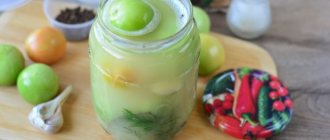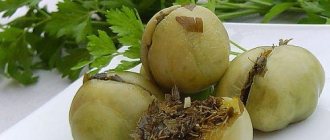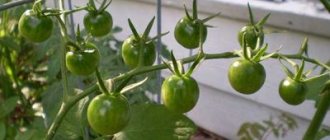It is not always possible to get a rich and, most importantly, ripe harvest in the fall. Sometimes, due to unpredictable weather conditions, it is necessary to collect vegetables that are not yet ripe. This is exactly what happens with tomatoes. It’s not a good idea to throw away an unripe product, so what can you do with it? Is it suitable for consumption? How can it help the body? These and other questions can be answered in this article.
Most often, people eat ripe tomatoes. Having collected unripe vegetables from their summer cottage, sometimes vegetable growers do not know what to do with them. You can collect them in a paper box and wait until they turn red and ripen, or you can make a lot of winter preparations that are in no way inferior in taste and usefulness to their ripened comrades, which the whole family will undoubtedly enjoy.
Composition and calorie content
Ripe tomatoes, of course, differ in their chemical composition and the number of calories from their unripe counterparts, which turn out to be less saturated with calories. 100 g of unripe tomatoes - 23 kcal. This vegetable is the richest in carbohydrates, it contains a minimal amount of protein, and practically no fat.
The composition of the unripe fruit is rich in vitamins A and B. There are macroelements such as phosphorus, calcium, magnesium, potassium, and sodium. The product is rich in iron, manganese, copper, zinc, selenium and aluminum. It contains amino acids: leucine, alanine, glycine, serine, methionine, cysteine, isoleucine, threonine, proline, phenylalanine, tyrosine, arginine, lysine, tryptophan, histidine, and valine, aspartic and glutamine, omega-3 fatty acids, and omega-6 acids. Water takes up most of the composition, but the vegetable is rich in dietary fiber, as well as ash.
An unripe fruit contains a harmful toxic substance that can adversely affect the general condition of the human body - solanine. In addition to it, tomato also contains tomatine and lycopene.
Solanine, a poisonous glycoalkaloid, protects vegetables from the appearance of mold before they ripen. Solanine in small quantities has a positive effect on the functioning of blood vessels and the heart. This glycoalkaloid has a diuretic effect, protects the body from viruses, and also has an antispasmodic effect. But if the permissible dosage is exceeded, it negatively affects the nervous system and destroys the function of oxygen transfer by red blood cells. You can get poisoned by unripe fruits quite quickly by eating 5 or 6 green tomatoes. There is pain in the temples, pain and discomfort in the abdomen, diarrhea and nausea begin. Poisoning with this substance has a high risk of death. Therefore, you should be quite careful when eating unripe fruits.
Another dangerous substance that contains poison and is part of unripe tomatoes is tomatine. Its content in unripe tomatoes is minimal, since to poison the body you need to eat 4–5 kilograms of tomatoes at once. Small doses of tomatine have a beneficial effect on the body due to the fact that it has antioxidant and immunomodulatory effects. This substance also promotes accelerated growth of muscle mass with the use of physical exercise and helps the body break down fats faster. Tomatine is the basis for the medical drug cortisone.
The color of the fruit depends on a substance such as lycopene. It serves as a powerful antioxidant and protector against mutating cells, inhibits the formation of cancerous inflammation and its effect on DNA, combats the development of cataracts, can prevent changes in the lens, and helps reduce the risk of atherosclerosis. This substance stabilizes blood pressure and lowers cholesterol levels.
This substance, unlike the previous two, does not have a toxic effect. The only thing that can happen with an overdose is a change in skin color. But this side effect goes away after eliminating the product from the diet.
Serotonin is also found in tomatoes; it is also called the hormone of happiness. This substance helps to improve the emotional state, having a beneficial effect on the working brain, and normalizes the transmission of nerve impulses in the human body.
Where is the most solanine?
Most solanine is in potatoes, but not in the tuber itself, but in the peel, sprouts and especially in the tops and stems. There are known cases of poisoning from potato leaves - people ate them as green vegetables. The tops are not even used in feeding farm animals. If you do not take into account the stems and foliage, then the most solanine is on damaged potatoes (around the site of damage), as well as in green areas.
The green color on potato tubers appears when exposed to sunlight. In these places, the concentration of chlorophyll, which is responsible for photosynthesis, increases (sprouts often appear from them). During these processes, the production of solanine is also activated. Therefore, such areas need to be peeled off along with the peel.
What are the benefits of green tomatoes?
Unripe fruits help the body cope with problems of the acid-base balance of the stomach, intestinal diseases, and varicose veins. Green tomato slices are excellent in the fight against varicose veins. Phytoncides, which are found in vegetables in small quantities, help reduce inflammation in the body. The beneficial macro- and microelements that make up tomatoes have an immunomodulatory effect on the entire body.
Green vegetables help lower blood pressure due to the large amount of potassium they contain, and support the stable functioning of both the nervous and muscular systems, on which the functioning of the heart directly depends.
Green tomatoes are an effective means of combating hypertension. Lycopene, which is found in the vegetable, helps reduce cholesterol.
Video:
beneficial properties of green tomatoes Expand
Pregnancy and lactation
Doctors generally do not advise consuming green vegetables during pregnancy or breastfeeding. Tomato is quite “capricious” and can cause intolerance, which manifests itself in the form of rashes on the body. In some cases, tomato intolerance during pregnancy may manifest itself in the form of drowsiness and weakness.
Green tomatoes in cosmetology
Weekly use of tomatoes in the form of masks will soften the epidermis, smooth out fine wrinkles, and give the face a fresh and rested look. The tomato mask enhances cell regeneration processes and restores the general condition of the skin. It penetrates into the deep layers of the epidermis, moisturizing them, evens out the complexion, helps eliminate inflammation and infections on the skin, and can cope with acne and pimples. A tomato mask tightens the pores on the face, copes well with excess pigments, helps whiten freckles and eliminate blackheads, stimulates the body to produce collagen, which affects the elasticity and firmness of the skin. Before using the tomato mask, it is recommended to conduct a test control to avoid negative consequences.
How to use
These tomatoes are one of the ingredients in delicious preparations for the winter. Many people enjoy eating them salted or pickled. There are many recipes for their preparation.
Attention! When cooked or salted, the harmful substances contained in green tomatoes are destroyed. Such healthy preparations can be eaten.
Soaking green tomatoes in salt water for several hours will also help fight solanine. If you change the water several times, the harmful solanine will go away.
Advice! The beneficial substances of tomatoes are best absorbed with products containing fats, both vegetable and animal.
Harm and contraindications
It is better not to consume unripe tomatoes for allergy sufferers, people who have problems with the kidneys, joints and bones, diseases of the pancreas, or cardiovascular pathologies. They are contraindicated during pregnancy and breastfeeding.
Including unripe tomatoes in excessive quantities in your diet can lead to poisoning due to the high solanine content. Problems can also arise with the liver due to the high content of nitrates.
How to minimize the harm of tomatoes and neutralize solanine
Scientists agree that green tomatoes contain too many organic acids, much more than ripe ones. In case of overdose, they have a harmful effect on the functioning of the pancreas and gallbladder. They are contraindicated for gallstone disease, as well as for gout and arthritis.
The nitrate content in green fruits is also overestimated (about 10-11 mg per 100 g of pulp), while small microdoses are found in red ones. And nitrates are harmful because, acting on oxygen, they deprive it of all activity. The result of this influence is expressed in a deficiency of hemoglobin in the blood, which disrupts liver function. And the body may even become poisoned.
It is believed that more than 5 eaten green tomatoes lead to poisoning of the body, and more than 10 pieces can cause death.
What to do? Don't eat green tomatoes or blanch them, which greatly reduces the amount of nitrates. Besides. To prevent the harm that fruits can cause to the body when eating green tomatoes, it is necessary to neutralize solanine. This is achieved by heat treating the fruits or soaking them in a saline solution for several hours.
In the first case, the vegetables are blanched for several minutes, or they are doused with boiling water two or three times. When soaking, it is advisable to change the saline solution several times. These simple measures significantly reduce the concentration of solanine in tomatoes and make them safe to eat.
Restrictions are also placed on the consumption of marinated or salted tomatoes; they can cause harm to people with gastrointestinal problems. It is not advisable to use them during pregnancy and breastfeeding. It must be remembered that green tomato can cause individual intolerance and allergic rashes.
What can be prepared from green tomatoes: recipes
Green tomatoes serve as an excellent product for winter preparations: preparing salads, caviar, adjika, lecho, sauces, dressings and much more. They will be no less tasty than with ripe tomatoes.
Salad
To make a salad from unripe vegetables, you need to prepare the following ingredients:
- unripe vegetables – 3 kg;
- fresh carrots – 1 kg 200 g;
- onions – half a kilogram;
- bell pepper – 200 g;
- granulated sugar – 1 cup;
- vegetable oil – 1 cup;
- ground red pepper – 10 g;
- salt – 25 g;
- tomato sauce – 500 g.
Cooking steps:
- Cut the tomatoes, onions, peppers into cubes, grate the carrots as for a Korean salad or chop them finely.
- Place all the preparations in one large container, mix everything, adding tomato sauce and seasoning with vegetable oil.
- Place the saucepan on the stove and bring the mixture to a boil.
- As soon as the mixture boils, add salt and sugar (and pepper the mixture). Cook the salad for about three hours, remembering to stir it periodically.
- As soon as the salad is prepared, immediately roll it into clean sterilized jars or sterilize it in hot water, after filling and covering the containers with lids.
- Roll up the jars and place them on a towel with the lids down until they cool completely.
Soup
In order to prepare soup from unripe tomatoes, you will need the following ingredients:
- chicken broth – 2 l;
- fresh cabbage – 350 g;
- potatoes – 250 g;
- bell pepper – 1 pc.;
- green tomatoes – 250 g;
- onions – 1 pc.;
- fresh carrots – 1 pc.;
- butter – 45 g;
- salt, pepper - to taste;
- tomato paste – 10 g;
- parsley for decoration.
Cooking steps:
- Cut potatoes, peppers and onions into cubes. Cut the tomatoes into small half-slices. Grate the carrots, chop the cabbage.
- Bring the chicken broth to a boil and add the potatoes.
- After 6 minutes, add fresh cabbage and green vegetables.
- In a heated frying pan with the addition of butter, sauté the carrots and onions, then add the pepper.
- Dilute the tomato paste in a small amount of water and add to the vegetables in the pan. Simmer the vegetables for no more than 5 minutes.
- Add the contents of the frying pan to the soup, simmer for no more than 3-4 minutes and turn off. Add salt.
- Before serving, garnish with fresh parsley and add ground pepper if desired.
Caviar
To prepare caviar you need to prepare the following ingredients:
- green tomatoes – 8 kg;
- fresh carrots – 1.5 kg;
- onions – 1–1.5 kg;
- refined vegetable oil – 400 g;
- granulated sugar – 200 g;
- salt – 150 g;
- ground black pepper – 15 g.
Cooking steps:
- Cut unripe tomatoes into small cubes or grind through a meat grinder with wide holes.
- Grate the carrots on a coarse grater.
- Dice the onion and add immediately to the carrots.
- Place the vegetables in a thick-bottomed container, adding vegetable oil, fry until the onions are golden brown.
- Add pepper, salt, tomatoes and sugar, mix everything.
- Reduce heat to low and simmer for about 2.5 hours.
- Place the salad in pasteurized jars and place in a warm place until it cools completely.
Adjika
To prepare adjika you need to prepare the following products:
- unripe tomatoes – 2 kg;
- hot pepper – 200 g;
- salt – 10 g;
- ground black pepper – 5 g;
- dry adjika – 10 g;
- refined sunflower oil – 80 g;
- table vinegar – 45 g;
- granulated sugar – 80 g;
- khmeli-suneli seasoning – 5 g;
- fresh parsley.
Cooking steps:
- Wash the tomatoes and cut into four parts.
- Peel the peppers from seeds, rinse the parsley - pass it all through a meat grinder.
- Place the mixture and chopped tomatoes in a saucepan, put on heat and bring to a boil.
- After boiling, add the remaining ingredients and cook for about 30 minutes. Depending on taste preferences, the amount of spices can be changed as desired.
- Place the finished mixture in pre-sterilized jars, close, and cool at normal room temperature.
Video:
adjika recipe from green tomatoes Expand
Lecho
For preparation you will need the following ingredients:
- green tomatoes – 1 kg;
- ripe tomatoes – 700 g;
- red bell pepper – 300 g;
- onion – 350 g;
- tomato paste – 20 g;
- refined sunflower oil – 100 ml;
- granulated sugar – 40 g;
- salt – 10 g;
- ground black pepper – 5 g;
- table vinegar – 50 ml.
Cooking steps:
- Wash all vegetables. Sort for unusable and spoiled parts before cooking.
- Cut green tomatoes into quarters and add plenty of salt so that they get rid of the harmful substance - solanine. Leave the tomatoes like this for several hours.
- Peel the onion and immediately cut into thin half rings, the pepper into large cubes.
- Pass the red tomatoes through a meat grinder or puree them in a blender.
- Place the resulting tomato puree in a saucepan, add salt, pepper and bring to a boil, boiling for about 5-6 minutes.
- Drain the juice from the green tomatoes; no need to rinse; add immediately to the hot sauce on the stove.
- Reduce heat and simmer for an hour, stirring occasionally.
- After this, add peppers and onions to the resulting mixture and simmer for about 20 minutes.
- It is worth checking the taste and adding salt and sugar if necessary. At the final stage of cooking, pour in table vinegar and boil again.
- Place in clean, sterilized jars and roll up. Place the lids down to cool, covered with a warm blanket.
Sauce
To prepare the sauce you need the following products:
- tomatoes – 1 kg;
- hot green pepper – 1 pc.;
- 1 medium garlic;
- granulated sugar – 1 cup;
- ground ginger – 5 g;
- salt – 5 g;
- juice of one lemon.
Cooking steps:
- Wash unripe fruits and remove stems. Place the vegetables in a colander and scald with boiling water. Place them in hot water for a few minutes. This will help get rid of the harmful toxic solanine, which is found in large quantities in green tomatoes.
- Cut the tomatoes into small pieces. Place them in a thick-bottomed saucepan, add sugar and leave for several hours.
- Place the pan on the fire and gradually bring to a boil.
- Cut the garlic and pepper into small pieces. It is important to remove all seeds from the pepper. After 20 minutes from the moment the tomatoes boil, add chopped vegetables, as well as lemon juice and a spoonful of dry ground ginger.
- Remove the container from the heat and let cool for about 2-3 hours. Then boil again and keep in this state for another 15 minutes on the stove.
- Place the resulting sauce in sterilized jars, then close the lids tightly and leave to cool, covered with a warm blanket or jacket.
Video:
how to make green tomato sauce Expand
Ketchup
For preparation you need the following ingredients:
- unripe tomatoes – 1 kg 500 g;
- 1 green medium apple;
- green hot pepper – 1 pc. or to taste;
- black peppercorns and salt, sugar - to taste;
- green onions and parsley leaves - 25 g each;
- a few cloves of fresh garlic;
- vinegar essence – 5 drops.
Cooking steps:
- Peel the apple and cut into small pieces.
- Cut unripe tomatoes into 4 parts and then simply pass through a meat grinder or grind into a pulp in a blender.
- Grind the apple pieces in a meat grinder or blender until the consistency of puree.
- Place the resulting mixtures in a thick-bottomed saucepan, stir and cook for about half an hour over low heat, skimming off any foam that forms.
- Add seasonings. Finely chop the onion, pepper and parsley, pass the garlic through a garlic press or grate it on a fine grater. Add pepper and salt with sugar.
- Mix everything and continue cooking over low heat for about another half hour. To obtain a more pleasant ketchup consistency, it is advisable to pass the mixture through a sieve.
- Bring the ingredients to a boil and add the essence, mix everything well.
- Place the prepared ketchup in washed and sterilized jars, close tightly and let rest, covered with a warm towel.
Jam
To prepare, you will need the following ingredients according to the recipe:
- green tomatoes – 1 kg;
- medium orange;
- granulated sugar – 250 g.
Cooking steps:
- Wash green vegetables, remove stems and soak for several hours in cold water.
- After this, cut into 4 parts, put in a large saucepan with a thick bottom, add sugar and put on fire to cook.
- Peel the orange; you don’t need to throw it away, it will come in handy. Squeeze all the juice out of it.
- At the final stage of preparing the jam, add orange peels, pour in the resulting juice and simmer for about 5 minutes.
- Place the jam in sterilized, clean jars and close the lids. Give it a rest.
Soaked green tomatoes
To prepare soaked green tomatoes you need to prepare the following products:
- unripe tomatoes – 2 kg;
- fresh garlic - 1 head;
- horseradish root – 3 pcs.;
- leaves of cherry, black currant, raspberry and horseradish - 1 bunch each;
- allspice peas – 12 pcs.;
- salt – 4 tbsp;
- laurel leaves – 5 pcs.;
- dry mustard – 2 tbsp;
- hot pepper – 1–2 pods.
Cooking steps:
- Prepare everything you need, wash and dry.
- Take a thick-bottomed pan or other deep container, place clean leaves on the bottom, and put tomatoes on top. Alternate layers until the end of the products.
- In between the layers place laurel leaves, garlic cloves, allspice grains and green pepper pods.
- Dissolve sugar and salt separately in a small amount of water. Pour the brine into the container with the tomatoes, add water so that all the tomatoes are completely in it.
- To prevent mold from forming, sprinkle mustard powder on top.
- Keep the tomatoes at room temperature for 14 days, then put them in a cool, dark place.
The finished product can be consumed a month after preparation.
Video:
how to cook barrel green tomatoes Expand
How to marinate and pickle
For cooking you need the following products:
- green tomatoes – 1 kg;
- garlic – 3 cloves;
- refined sunflower oil – 2 tbsp;
- granulated sugar – 3 tbsp;
- salt – 2–3 tbsp. or to taste;
- table vinegar 9% – 200 ml.
Cooking steps:
- Wash the tomatoes and cut into slices.
- Peel the garlic and chop in a garlic press. Add a mixture of vinegar, salt and sugar to the vegetables.
- Add refined sunflower oil to the resulting mass.
- Cover with a lid or wrap tightly with cling film and place in a cool place.
- Leave to marinate for 2-3 days. After the time has passed, the pickled tomatoes are ready to eat.
Recipe 2
For cooking in the kitchen you need the following components:
- green tomatoes – 10 kg;
- black currant leaves – 10 pcs.;
- bitter green pepper – 2 pcs.;
- parsley – 2–3 bunches;
- green dill – 210 g;
- 70 g of salt for every liter of water.
Process:
- Wash the tomatoes and place them at the bottom of the container, adding all the necessary spices.
- Sprinkle everything with salt.
- Fill the container with cold water so that it covers the topmost layer of vegetables.
Interesting facts about tomatoes
Let's look at 5 unusual facts about tomatoes that quite a few people know about.
Fact 1: Previously considered poisonous
According to historical data, the first wild tomatoes were tried by the Indians. They called these vegetables “tomatli,” which translates as “large berry.” This is where the botanical classification of fruits comes from, designating tomatoes as berries.
In Europe, ancient people were afraid to eat tomatoes. For example, in Italy they were called “golden apples” and were considered poisonous for quite a long period of time. Quite complex “relationships” with this culture developed in Russia.
Only in the 19th century did attitudes towards vegetables change. Farmers began to crossbreed different varieties of vegetables, and bred selective tomatoes that had a sweeter taste.
Fact 2: Tomatoes are a cure for death
Doctors call tomatoes “vegetables of longevity.” The thing is that the red color of vegetables is due to the presence of the carotenoid lycopene in them. Once in our body, this substance acts as a strong antioxidant, protecting every cell from exhaustion.
Recent scientific studies have shown that people whose bodies contain 25% more lycopene suffer much less from strokes, and overall mortality is reduced by 37%.
Moreover, even heat treatment of vegetables does not “kill” the beneficial lycopene, and quite the contrary - a stewed or fried tomato contains much more useful things than a fresh one.
Fact 3: Mutant tomatoes
A couple of years ago, unusual news was circulating on the Internet. Like, “a Spanish scientist died of a GMO tomato that had fish genes because he had an allergy.” A certain category of citizens continues to refer to this news as something that confirms the risk of death from tomatoes.
In reality, this story was invented “from cover to cover.” That is, the authors of the site where the “news” was published decided to just joke. In reality, nothing like this happened, but gullible, naive people who did not know how to check information believed it.
Fact 4: Do not store in the refrigerator
According to the latest scientific research, tomatoes contain aromatic substances that emit a pleasant aroma. So, they quickly deteriorate if vegetables are stored at sub-zero temperatures.
Therefore, experts advise storing tomatoes at room temperature. Firstly, they will last much longer this way. Secondly, they will not lose their taste and pleasant smell.
Fact 5: Ocean Rescuers
Tomato is about tuna. Already today, Canadian and American restaurants offer to try this delicacy. It is ideal for vegetarians, and allows you to avoid killing a huge number of fish.
In potatoes
When do potatoes have a lot of solanine? Let's consider what affects the accumulation of poison in a plant.
- Low agricultural technology. The amount of solanine in potatoes increases if they were not grown correctly. So, shallowly planted potatoes produce tubers that grow near the surface of the soil. When exposed to the sun, they turn green and acquire a bitter taste. That's why it's so important to hill potatoes. If the plant is planted in sandy soil, the amount of poison in the potato will be increased.
- New potatoes. Unripe potatoes also contain a lot of solanine. However, as the plant ages, their number decreases.
- For long-term storage. The amount of solanine increases 4 times if the potatoes have been stored for a long time, especially when the potatoes sprout.
- In case of mechanical damage. Its quantity increases if the tubers are damaged during harvesting or transportation.
- Potato variety. This poison is found more or less in different varieties of potatoes.
Toxicity [edit | edit code ]
Solanine has fungicidal and insecticidal properties, acting as a natural plant protection. Solanine causes excitement and then depression of the nervous system, decomposition of red blood cells. Solanine can be toxic to humans and animals. Thanks to a significant reduction in the solanine content in modern potatoes, intoxication has become rare. After cleaning, only 5-10% of the original solanine remains in the tuber [2]. Solanine poisoning is possible after eating several kilograms of unpeeled, unheated, unripe potatoes [3] [4]. If there are green areas in the tuber, then the solanine content in them is noticeably higher, so when peeling potatoes it is better to cut off such areas.
Solanine poisoning is manifested by symptoms such as nausea, vomiting, abdominal pain, headache, diarrhea, confusion, dilated pupils and fever; in severe cases, delirium, coma and convulsions are observed. The lethal dose for rabbits is estimated at 0.06-0.12 grams per kg of body weight, for dogs - slightly more than 0.6 g/kg [5]. Treatment of solanine poisoning is symptomatic: gastric lavage, activated charcoal and laxatives, and, if necessary, intravenous rehydration [6].
Distribution[edit | edit code ]
Contained in any part of the plant - in leaves, fruits, stems, tubers, etc. The highest content of solanine is observed in the unripe berries of black nightshade ( Solanum nigrum
) and in all parts of the bittersweet nightshade (
Solanum dulcamara
) [1]. Tubers of edible potatoes contain up to 0.05% solanine (in sprouted, greened tubers, the level of solanine increases significantly), and the highest concentration of solanine is observed directly in the peel and sprouts. Solanine is also found in unripe tomatoes, but when the tomato fruit grows to the size characteristic of its variety and begins to lighten, becoming whitish or slightly pinkish, the solanine content decreases and such fruits become edible after cooking (pickling or salting).
Contraindications to the use of green tomatoes
There are certain diseases for which the consumption of tomatoes is prohibited. These are problems with joints, kidney diseases, gall bladder, allergic reactions. Everyone else can and should eat tomatoes, but in reasonable quantities.
Any product consumed by a person has certain benefits and can cause harm. It’s only a matter of their ratio, the correct choice of processing method and the correctly selected rate of use.
Tomato is the most popular and beloved vegetable by many, which is eaten both green and red. But few people know whether it is possible to eat green tomatoes and how to cook them in order to get the benefits and not harm the body. Unripe fruits contain toxic substances. One of them is solanine, a high dose of which causes poisoning, so you need to be aware of the possible harm of this vegetable.
Is there any harm from eating tomatoes?
Despite the obvious benefits, you can always find even a small number of people for whom, for some reason, tasty pickles are not suitable.
Rare cases include:
- Individual non-perception.
- Diseases of the organs responsible for genitourinary function, inflammatory diseases (pyelonephritis, cholecystitis, urolithiasis). Salt and oxalic acid can make changes to the water-salt balance, as well as slow down the removal of fluid from the body, thereby aggravating the course of existing diseases.
- Hypertension. A large amount of salt in the composition increases blood pressure.
- Ulcers and gastritis. Recipes containing vinegar are contraindicated.
- Children are sensitive to various foods. It is better to give salted tomatoes in small portions with careful monitoring of the body's reaction. When consuming a large amount of this preservation, rashes, itching, allergies, and diathesis are possible. A slight increase in temperature may occur.
A simple and quick recipe for pickling tomatoes “From Grandmother Emma”
This is an emergency method, resulting in tomatoes that are ready to eat within 4 days.
At the bottom of the container lay herbs (parsley, celery, dill, cherry leaves), hot pepper, 5 cloves of garlic. Each berry is cut and placed in a container on a green pillow. Cover with herbs on top and add garlic. Prepare the brine: Boil water (5 l) with the addition of salt (5 heaped tablespoons) and sugar (10 tablespoons). Pour the prepared solution over the tomatoes and cover with a lid. Leave for a day under normal conditions, then place in the refrigerator for three days until fully prepared.
canned beans - benefits and harms











